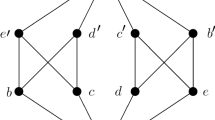Abstract
In 1996, Harding showed that the binarydecompositions of any algebraic, relational, ortopological structure X form an orthomodular poset FactX. Here, we begin an investigation of the structuralproperties of such orthomodular posets of decompositions.We show that a finite set S of binary decompositions inFact X is compatible if and only if all the binarydecompositions in S can be built from a common n-arydecomposition of X. This characterization ofcompatibility is used to show that for any algebraic,relational, or topological structure X, the orthomodularposet Fact X is regular. Special cases of this result include the known facts that theorthomodular posets of splitting subspaces of an innerproduct space are regular, and that the orthomodularposets constructed from the idempotents of a ring are regular. This result also establishes theregularity of the orthomodular posets that Mushtariconstructs from bounded modular lattices, theorthomodular posets one constructs from the subgroups ofa group, and the orthomodular posets oneconstructs from a normed group with operators. Moreover,all these orthomodular posets are regular for the samereason. The characterization of compatibility is also used to show that for any structure X, thefinite Boolean subalgebras of Fact X correspond tofinitary direct product decompositions of the structureX. For algebraic and relational structures X, this result is extended to show that the Booleansubalgebras of Fact X correspond to representations ofthe structure X as the global sections of a sheaf ofstructures over a Boolean space. The above results can be given a physical interpretation as well.Assume that the true or false questions \(Q\) of a quantum mechanical system correspond tobinary direct product decompositions of the state spaceof the system, as is the case with the usual von Neumanninterpretation of quantum mechanics. Suppose S is asubset of \(Q\). Then a necessary andsufficient condition that all questions in S can beanswered simultaneously is that any two questions in S can be answeredsimultaneously. Thus, regularity in quantum mechanicsfollows from the assumption that questions correspond todecompositions.
Similar content being viewed by others
REFERENCES
Arens, R., and Kaplansky, I. (1949). Topological representations of algebras, Transactions of the AMS 63, 457–481.
Beran, L. (1984). Orthomodular Lattices, Algebraic Approach, Academia, Prague/Reidel, Dordrecht.
Birkhoff, G. (1967). Lattice Theory, 3rd ed., American Mathematical Society, Providence, Rhode Island.
Birkhoff, G., and von Neumann, J. (1936). The logic of quantum mechanics, Annals of Mathematics, 37, 823–843.
Brabec, J. (1979). Compatibility in orthomodular posets, Casopis pro Pestovani Matematiky, 104, 149–153.
Brabec, J., and Pták, P. (1982). On compatibility in quantum logics, Foundations of Physics, 12, 207–212.
Burris, S., and Sankappanavar, H. P. (1981). A Course in Universal Algebra, Springer, Berlin.
Chin, L. H., and Tarski, A. (1951). Distributive and modular laws in relation algebras, University of California Publication in Mathematics New Series, 1, 341–383.
Comer, S. D. (1971). Representations by algebras of sections over Boolean spaces, Pacific Journal of Mathematics, 38, 29–38.
Davey, B. A. (1973). Sheaf spaces and sheaves of universal algebras, Mathematische Zeitschrift, 134, 275–290.
Dvurečenskij, A. (1993). Gleason's Theorem and Its Applications, Kluwer.
Flachsmeyer, J. (1982). A note on orthocomplemente d posets, in Proceedings Conference on Topology and Measure, Part III, Greifswald, pp. 65–75.
Harding, J. (1993). Completions of orthomodular lattices II, Order 10, 283–294.
Harding, J. (1996). Decompositions in quantum logic, Transactions of the AMS, 348(5), 1839–1862.
Jónsson, B. (1982). Varieties of relation algebras, Algebra Universalis, 15, 273–298.
Kalmbach, G. (1983). Orthomodular Lattices, Academic Press, New York.
Katrnoška, F. (1990). Logics of idempotents of rings, in Proceedings Winter School on Measure Theory II, Liptovský Ján, pp. 100–104.
Kelly, J. L. (1955). General Topology, Van Nostrand, New York.
Macintyre, A. (1973). Model-completeness for sheaves of structures, Fundamenta Mathematicae, 81, 73–89.
Mackey, G. W. (1963). The Mathematical Foundations of Quantum Mechanics, Benjamin, New York.
Mushtari, D. Kh. (1989). Projection logics in Banach spaces, Soviet Mathematics-Iz. VUZ, 33, 59–70.
Neubrunn, T., and Pulmannová, S. (1983). On compatibility in quantum logics, Acta Facultatis Universitatis Comenianae. Mathematica, 42–43, 153–168.
Pierce, R. S. (1967). Modules over commutative regular rings, Memoirs of the American Mathematical Society, 70.
Piron, C. (1976). Foundations of Quantum Physics, Benjamin, New York.
Pták, P., and Pulmannová, S. (1991). Orthomodular Structures as Quantum Logics, Veda, Bratislava.
Pulmannová, S. (1981). Compatibility and partial compatibility in quantum logics, Foundations of Physics 11, 127–136.
Swan, G. (1964). The Theory of Sheaves, University of Chicago Press, Chicago.
Tarski, A. (1941). On the calculus of binary relations, Journal of Symbolic Logic, 6, 73–89.
van der Waerden, B. L. (1949). Modern Algebra, Ungar, New York.
Varadarajan, V. S. (1985). Geometry of Quantum Theory, 2nd ed., Springer, Berlin.
von Neumann, J. (1932). Mathematische Grundlagen der Quantenmechani k, Springer, Berlin.
Rights and permissions
About this article
Cite this article
Harding, J. Regularity in Quantum Logic. International Journal of Theoretical Physics 37, 1173–1212 (1998). https://doi.org/10.1023/A:1026665818335
Issue Date:
DOI: https://doi.org/10.1023/A:1026665818335




